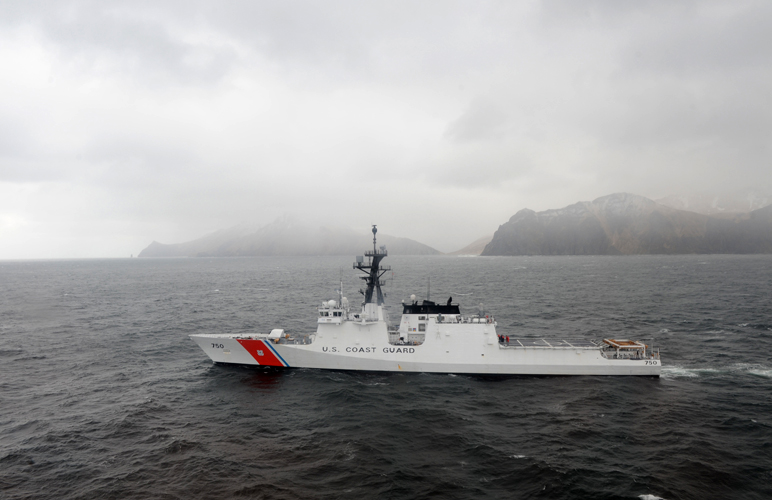Here’s what the US federal government shutdown means for the Arctic
The partial government shutdown will have lasting implications for the United States' role in the circumpolar region, experts say.

The United States’ federal government is entering the third week of a partial shutdown, as negotiations continue without any apparent progress, and the U.S. Arctic — and America’s broader role in the region — are affected.
Several key U.S. agencies operating in the region have been fully or partially shut down, and important scientific research, policymaking initiatives, natural resource exploration and other U.S. interests in the Arctic have been put on hold until a budget is passed.
These delays will have lasting implications for the United States’ role in the circumpolar region, experts say.
The Coast Guard operates partially — without pay
The Coast Guard managed to stretch its 2018 budget until the end of the year. But as of January 1, none of its employees are being paid.
Even in the absence of new funding or a continuing resolution that would allow the agency to pay its employees, the Coast Guard is required to continue some of its operations — those that “provide for national security, or that protect life and property,” according a statement about the shutdown on the Coast Guard’s website.
That means active-duty military members of the Coast Guard continue to work through the shutdown — patrolling borders, engaging in search-and-rescue, and more — without pay. All other nonessential duties and activities have been suspended or terminated during the shutdown.
Paul Zukunft, retired admiral of the Coast Guard, told ArcticToday that he is “keenly aware” of the effects of the stalled appropriations process, particularly upon the recapitalization of the U.S. polar icebreaking fleet.
“We are losing precious time working with industry to lock down a contract for final design and start cutting steel on a heavy icebreaker while our only heavy icebreaker approaches the end of its service life,” he said.
“This is truly a race against time and these delays do not play in our favor as an Arctic nation,” he said.
The budget showdown doesn’t just delay recapitalization of the icebreaker fleet; it could eliminate funding for a new heavy icebreaker entirely. The House GOP version of the budget jettisoned funding for the vessel last summer in favor of increased southern border security — the same multibillion-dollar project at the center of the current shutdown.
While Democrats created a new budget when they took control of the House, it’s uncertain whether icebreaker funding will be reinstated in the final version.
And the Coast Guard doesn’t just provide border security and search-and-rescue operations; it also conducts important research in the Arctic.
Research and policy initiatives lag behind
Many federal employees conducting research and setting policies in the Arctic have also been furloughed without pay — including those at the National Oceanic and Atmospheric Administration, NASA, the Environmental Protection Agency, U.S. Fish and Wildlife Service, the National Park Service, U.S. Geological Survey, Bureau of Ocean Energy Management and other agencies.
The U.S. Arctic Research Commission ceased sending its daily Arctic newsletter.
Most federal research and science personnel are considered nonessential, meaning any researchers working on Arctic projects are likely furloughed right now. This will delay scientific research and national policymaking in the region — and the effects will be felt beyond this shutdown.
For the Arctic in particular, the shutdown could adversely affect federal climate science by creating backlogs of data that must be analyzed when scientists return to work. Furthermore, it will adds funding uncertainty for projects that rely on federal dollars, because all such projects are essentially on the chopping block during the budget negotiations.
Tourism tests limits and halts research in national parks
While some national parks remain open to visitors, National Park Service staff has been furloughed.
The five park units in Arctic Alaska — the Bering Land Bridge National Preserve, Cape Krusenstern National Monument, Gates of the Arctic National Park and Preserve, Kobuk Valley National Park, and Noatak National Preserve — are remote and offer few services to begin with, so they’ll be largely spared some of the issues (such as trash piling up) that are plaguing other parks.
The Northwest Arctic Heritage Center in Kotzebue, run by NPS, is closed to all visitors during the government shutdown.
More significantly, conservation projects and research efforts on Arctic ecosystems there will be stalled as long as the shutdown persists.
Natural resource extraction put on hold
The Bureau of Land Management and the U.S. Fish and Wildlife Service are both involved in the permitting process for natural resource exploration in the Arctic, including seismic testing for oil.
The Bureau of Land Management and the U.S. Fish and Wildlife Service are both involved in the permitting process for natural resource exploration in the Arctic, including seismic testing for oil.
Despite the partial shutdown, BLM has continued to hold public hearings on drilling permits in the National Petroleum Reserve. A BLM spokesman told Reuters that the hearings were exempt from the shutdown, saying that “the Bureau continues to process permit applications as they are an exempted activity during a lapse in appropriations.”
On Wednesday, however, the agency postponed similar hearings on oil exploration in the Arctic National Wildlife Refuge.
This story was updated to reflect that status of oil exploration permits and hearings.